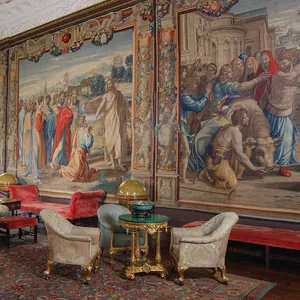The Mortlake Tapestries
The Mortlake Tapestries on the walls in The Saloon are the most important works of art in the Abbey. They are woven from the cartoons painted by Raphael, that are now on display in the Victoria and Albert Museum and depict the scenes from the lives of St Peter and St Paul, as described in St John’s Gospel and Acts of the Aspostles. The original tapestries were commissioned for the Sistine Chapel, in Rome, by Pope Julius II, and were first woven in Brussels in about 1520. This set was made in London at the Mortlake factory about hundred year later.

Woven shorter than the originals
Five of Raphael’s seven cartoons are depicted in the tapestries: The Miraculous Draft of Fishes, Panel from ‘The Death of Ananias,’ The Healing of the Lame Man, Christ’s charge of St Peter and The Sacrifice at Lystra before St Paul and St. Barnabus.
All except ‘The Miraculous Draft of Fishes’ were woven shorter than the originals. The unique border, possible from originals by Clein, were then applied to fit them to the available spaces.
These tapestries have hung here for about 300 years. They were ordered for the room by Sir Edmund Prideaux. However due to the support given to the Duke of Monmouth by his son (or at least the perceived support in way of a dinner invitation some six years prior to the rebellion), they were confiscated, and kept rolled up in Whitehall until they were presented to Francis Gwyn by Queen Anne in recognition of his work as Secretary of State for War.

